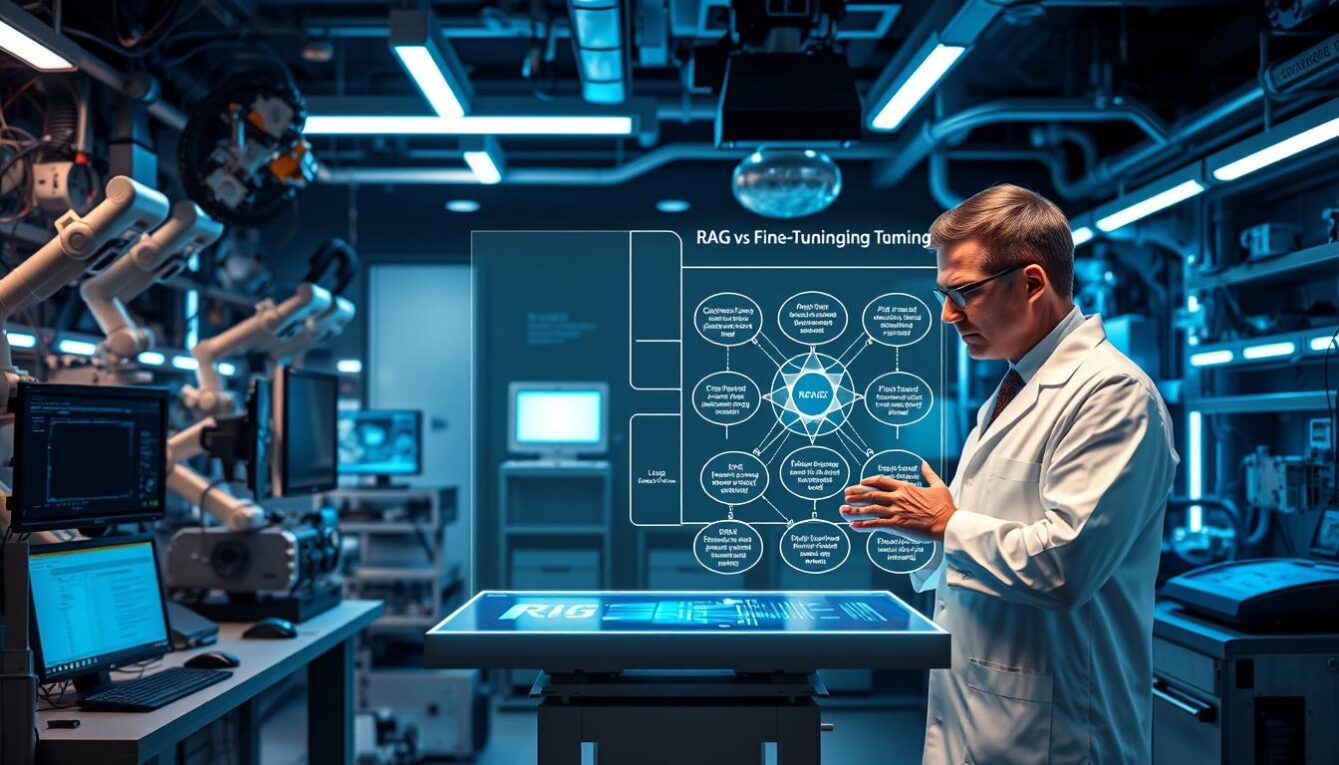When we talk about Generative AI, people often ask about the best way to use Large Language Models (LLMs). The debate is between Retrieval-Augmented Generation (RAG) and fine-tuning LLMs.
Did you know choosing between RAG and fine-tuning can really change how well your AI works? I’ve worked on improving how we talk to machines. I’ll share tips to help you pick the best way for your project.

It’s important to know what each method does well and what it doesn’t. In this article, I’ll dive deep into both options. This will help you choose the best way to customize your LLM for your needs.
Key Takeaways
- Understand the core differences between RAG and fine-tuning LLMs.
- Learn how to choose the right approach for your generative AI project.
- Discover the impact of each method on your project’s performance.
- Gain insights into the practical applications of RAG and fine-tuning.
- Make an informed decision for your LLM Customization needs.
Understanding RAG (Retrieval-Augmented Generation)
RAG is key in Generative AI. It mixes retrieval and generation. This mix helps RAG solve hard tasks that other AI models can’t.
What is RAG?
Retrieval-Augmented Generation (RAG) combines two AI ways. It uses a knowledge base and makes text from what it finds. This makes RAG great for many uses.
RAG’s architecture has two parts: a retriever and a generator. The retriever finds important info. The generator makes text from that info. This dual-process approach makes RAG’s text more accurate and right for the situation.
Key Components of RAG
RAG works well because of its main parts: the retriever, generator, and knowledge base. Each part is important for RAG’s success.
- The retriever finds important documents or data from the knowledge base.
- The generator makes text from what it finds. This text is clear and fits the situation.
- The knowledge base is the base for the retriever. It gives the data needed for good answers.
Use Cases for RAG
RAG is useful in many areas, like customer service, making content, and research. It gives accurate and fitting info, which is very helpful.
In customer service, RAG can make detailed and correct answers. This improves the customer’s experience. In content making, RAG helps create top-notch content by giving the right info and ideas.
Introduction to Fine-Tuning
Fine-tuning is key for making pre-trained LLMs work better for certain tasks. It tweaks the model’s settings to fit the task better. This makes the model work better and more customized.
Definition of Fine-Tuning
Fine-tuning means taking a pre-trained LLM and training it more on a specific dataset. It uses the model’s initial knowledge to make it better for a certain task. This makes the model more precise for its new task.
Benefits of Fine-Tuning
Fine-tuning has many benefits. It makes the model work better on specific tasks. It also helps the model adapt to new data and meet specific needs. This way, developers can get more accurate and relevant results.
Applications in Generative AI
Fine-tuning is very useful in Generative AI. It helps create more advanced and specific models. For example, it can make models that create high-quality content, like text or images, for certain industries.
| Model Characteristic | Pre-Fine-Tuning | Post-Fine-Tuning |
|---|---|---|
| Accuracy | 80% | 95% |
| Relevance | 70% | 90% |
| Customization Level | Low | High |
The table shows fine-tuning boosts the model’s accuracy, relevance, and customization. This makes it very useful for Generative AI.
Comparing RAG and Fine-Tuning
RAG and fine-tuning are two ways to make Generative AI better. Each has its own good points and not-so-good points. Let’s look at what makes them different.
Performance Metrics
When we talk about RAG and fine-tuning, we look at how well they do things. We check if they’re accurate, relevant, and can handle tough questions. RAG is great at finding the latest info or specific knowledge because it can search well.
Fine-tuning, however, makes models better at certain tasks. It changes the model to fit the task’s needs.
Comparison of Performance Metrics:
| Metric | RAG | Fine-Tuning |
|---|---|---|
| Accuracy | High | Very High |
| Relevance | High | High |
| Handling Complex Queries | Excellent | Good |
Flexibility and Adaptability
Being flexible and adaptable is key for Generative AI to work well. RAG is flexible because it can find info from many places. It’s good at keeping up with new or changing info.
Fine-tuning is great for specific tasks but might not be as flexible for new tasks without more training.
Resource Requirements
RAG and fine-tuning need different things to work. RAG needs lots of computer power and storage for its info search. Fine-tuning also needs computer power, especially for big models, but it doesn’t need extra storage.
In short, picking between RAG and fine-tuning depends on what your project needs. You should think about the task, the need for fresh info, and how much computer power you have.
When to Use RAG
Knowing when to use Generative AI is key. RAG is great when you need to use a big knowledge base. It’s also good for making text based on what it finds.
Ideal Scenarios for RAG
RAG is best when you need to find specific info. For example, making text that needs the latest facts. It uses a big knowledge base to make sure the text is right and useful.
This makes it perfect for things like:
- Automated reporting
- Content generation based on specific data
- Question-answering systems
In these cases, RAG makes the text better and more reliable.
Industries That Benefit Most
Many industries can really use RAG in their AI. These include:
| Industry | Application of RAG | Benefits |
|---|---|---|
| Finance | Automated financial reporting, analysis | Accuracy, timeliness |
| Healthcare | Medical content generation, patient data analysis | Relevance, compliance with regulations |
| Education | Personalized learning materials, automated grading | Customization, efficiency |
Understanding when to use RAG helps businesses improve their AI. They can make smart choices about when to use it.
When to Opt for Fine-Tuning
Fine-tuning is key in generative AI. It helps make pre-trained models fit special datasets or tasks. The choice to fine-tune depends on the project’s needs. This includes the task’s nature, the dataset’s characteristics, and how much customization is wanted.
Ideal Scenarios for Fine-Tuning
Fine-tuning is great when a model needs to be tailored for a specific task or dataset. Ideal scenarios include:
- When the task needs a lot of domain-specific knowledge.
- When the dataset is very different from the pre-trained model’s training data.
- When the project needs a high level of customization that other methods can’t provide.
In these cases, fine-tuning makes the pre-trained model fit the task or dataset’s needs. This leads to better performance and more accurate results.
Industries That Benefit Most
Many industries see big benefits from fine-tuning LLMs. These include:
- Healthcare: Fine-tuning helps adapt models for medical diagnosis, patient data analysis, and personalized medicine.
- Finance: Customizing models for financial forecasting, risk analysis, and portfolio management.
- Legal: Fine-tuning models for legal document analysis, contract review, and compliance monitoring.
By fine-tuning LLMs, these industries can use generative AI to innovate, improve efficiency, and meet their goals.
Hybrid Approaches Combining RAG and Fine-Tuning
Developers mix RAG and fine-tuning to make better models. These models use RAG’s search skills and fine-tuning’s flexibility. This mix makes AI more powerful.
Hybrid models in AI are new but promising. Experts say mixing AI ways makes models better.
“The future of AI lies in hybrid approaches that can adapt to various tasks and domains.” —
Advantages of Hybrid Models
Hybrid models have many good points. They include:
- Improved Accuracy: They get better at many tasks because of RAG and fine-tuning.
- Enhanced Flexibility: They work well in different areas and tasks. This makes them more useful.
- Better Handling of Complex Tasks: RAG and fine-tuning together help solve hard tasks better.

Successful Implementations
Many projects show how good hybrid models are. For example, a project for answering questions got much better with RAG and fine-tuning together.
In content making, mixing RAG and fine-tuning made texts better. They were more clear and right for the situation.
These examples show how hybrid models can make AI better and more useful.
Challenges of RAG
Exploring Retrieval-Augmented Generation (RAG) reveals its challenges. RAG boosts generative AI but faces hurdles.
Common Obstacles
Handling big knowledge bases is a big challenge. As bases grow, finding the right info gets harder. This can slow things down.
Finding the best info is another hurdle. RAG needs to pick the most accurate info from big bases. But, this is tough with lots of data.
Strategies for Overcoming These Challenges
To beat RAG’s challenges, we can use smart strategies. Using fast indexing and retrieval helps a lot. Methods like dense passage retrieval work well.
Improving the knowledge base is also key. Cleaning up data and keeping it fresh helps. This makes RAG better.
Using a mix of RAG and other methods is smart too. This way, we get stronger AI models. It’s all about combining the best techniques.
Challenges of Fine-Tuning
Fine-tuning is key in LLM customization. But, it has big challenges. Overfitting risks and data management issues are two big ones.
Overfitting Risks
Overfitting happens when a model fits too well to a dataset. It then does poorly on new data. This can happen if the dataset is small or the model is too complex.
To avoid this, you can:
- Use techniques like regularization and early stopping
- Watch how the model does on a validation set
- Make sure the training dataset is diverse and real
These steps help lower overfitting risks. They make the model better at handling new data.
Data Management Issues
Managing data is another big challenge in fine-tuning. Big or complex datasets can be hard to handle. Bad data quality can hurt the model’s performance.
Some ways to deal with this include:
- Using strong data preprocessing
- Adding data augmentation to make the dataset bigger and more diverse
- Checking that data is well labeled and annotated
Good data management is key for fine-tuning success. By using these strategies, you can make your dataset better. This will help your model perform better.
In conclusion, fine-tuning is powerful for LLM customization. But, it has its challenges. By understanding and tackling these challenges, you can make fine-tuning work better. This will help you get better results in your AI projects.
Future Trends in RAG and Fine-Tuning
Looking ahead, we see big changes in generative AI. New trends in RAG and fine-tuning are coming. These changes will make AI better and more flexible.
New tech is making RAG better. It can now handle text, images, audio, and video. This makes RAG useful in many fields.
Emerging Technologies Influencing RAG
New tech like natural language processing (NLP) and computer vision are helping RAG. They make RAG understand and create more complex content.
There’s also a push for better ways to search through lots of data. This will make RAG faster and more reliable.
Innovations in Fine-Tuning Methods
Fine-tuning is getting better too. New methods make it easier and faster. This helps more companies use AI.
People are also working on transfer learning and few-shot learning. These help models learn from little data. This is great when data is hard to get.
Keeping up with these trends helps companies use AI wisely. They can use RAG and fine-tuning to be more creative and efficient.
Cost Considerations
Choosing between RAG and fine-tuning for LLMs means looking at costs. Each method has its own financial needs for setup and upkeep.
Cost Analysis of RAG vs Fine-Tuning
The cost to use RAG or fine-tuning changes based on several things. These include the dataset size, computer power needed, and model complexity.
RAG costs come from setting up and keeping the retrieval system. It might need less training data than fine-tuning.
Fine-tuning needs a big upfront cost for data and computer power. The cost goes up with the model’s size and complexity.
- RAG: Infrastructure costs, retrieval model development
- Fine-Tuning: Dataset preparation, computational resources for training
Budgeting for LLM Approaches
When planning your LLM budget, think about both the start-up costs and ongoing expenses. This is true for both RAG and fine-tuning.
For RAG, plan for the cost of making the retrieval system. Also, think about scaling costs later. For fine-tuning, focus on getting the data and the computer power for training.
| Cost Factor | RAG | Fine-Tuning |
|---|---|---|
| Initial Development | Retrieval infrastructure | Dataset preparation |
| Ongoing Expenses | Maintenance, scaling | Model updates, retraining |
Looking at these costs helps organizations choose the right LLM path. This ensures they stay within their budget and meet their project goals.
Best Practices for Implementing RAG
Using RAG well needs tech skills and planning ahead. I’ve seen how important it is to plan and do things right in Generative AI projects.
Steps to Successful RAG Implementation
To do RAG right, follow these steps:
- Define Clear Objectives: Know what you want to get from RAG, like better answers or a better user experience.
- Select Appropriate Data Sources: Pick data that’s right, true, and current for the best results.
- Configure the RAG Model: Adjust the model to work best for your needs.
- Integrate with Existing Systems: Make sure it works well with what you already have to avoid problems.
These steps help you start strong with RAG.
Monitoring and Evaluation Techniques
Keeping an eye on things and checking how it’s doing is key. Here are some ways to do that:
- Performance Metrics: Watch things like how accurate the answers are, how users like it, and how fast it works.
- Continuous Feedback Loop: Have a way for users to say what they think, so you can make it better.
- Regular Updates and Maintenance: Keep the data fresh and the model sharp to meet new needs and get better.
Experts say, “Keeping an eye on it and making changes is crucial for RAG in Generative AI.”
Using RAG with ongoing checks and tweaks can really boost how well Generative AI systems work.
By following these tips and always improving, you can make the most of RAG in your Generative AI projects.
Best Practices for Implementing Fine-Tuning
Getting the most out of large language models (LLMs) needs a smart plan. Choosing the right data, adapting the model, and checking the results are key. These steps help make LLMs work just for you.
Steps to Effective Fine-Tuning
First, pick a dataset that fits your needs. It should be varied and well-labeled. This helps the model learn the right things.
Then, adjust the pre-trained model to your data. Change settings as needed to get the best results.
Ensuring Quality in Outputs
Checking the model’s output is very important. Use a strong test to see how well it does. Look at things like how accurate and clear it is.
Keep watching how the model does and tweak it as needed. This way, you get the best results for your use.
By following these steps, you can make LLMs work great for you. You’ll get solutions that really fit your needs.










